- Forum
- categories
- Sanitation systems
- Faecal sludge management (FSM)
- Determining helminth egg quantities (measurement techniques)
- Developing a uniform Soil-transmitted helminth (STH) analysis consortium for analyzing fecal waste samples (DUT, South Africa) - helminth egg measurements
Developing a uniform Soil-transmitted helminth (STH) analysis consortium for analyzing fecal waste samples (DUT, South Africa) - helminth egg measurements
12.1k views
- Elisabeth
-
Topic Author
- User is blocked
- Freelance consultant since 2012
Less- Posts: 3372
- Karma: 54
- Likes received: 932
Re: Workshop on "Developing a uniform Soil Transmitted Helminth (STH) analysis consortium for analyzing faecal waste samples" - on 23 February 2017 at FSM4, Chennai, India
Effect of reagents used during detection and quantification of Ascaris suum in environmental samples on egg viability
by Isaac Dennis Amoah, Poovendhree Reddy, Thor Axel Stenström
wst.iwaponline.com/content/76/9/2389?etoc
It's part of this project funded by the Gates Foundation ("Developing a uniform Soil-transmitted helminth (STH) analysis consortium for analyzing fecal waste samples") which is why I am posting about it in this thread.
The Abstract:
Soil-transmitted helminths (STHs) are a major health concern globally. Infection is mostly through contact with contaminated water, food or soil. Therefore to break the cycle of viable transmission STH eggs must be quantitatively detected in the environment. The effect of different reagents on the viability of Ascaris suum eggs during laboratory detection and quantification was assessed and different incubation solutions compared. Sulphuric acid gave a slightly higher recovery percentage of viable eggs (91.2%) than distilled water (90.0%) and 0.5% formalin (87.6%), although the difference was not statistically significant (p > 0.05). Acetoacetic acid, ethyl acetate, ammonium bicarbonate, zinc sulphate, magnesium sulphate and Tween 80, are reagents widely used in test protocols for the detection and quantification of STH eggs. Eggs were exposed to these reagents for different time durations. Acetoacetic acid resulted in the highest loss of viability (3.4 ± 0.7% viable), while magnesium sulphate resulted in the least effect (88.5 ± 1.2% viable). In conclusion the use of the selected reagents in the detection of these eggs was found to affect the viability of exposed eggs, especially during prolonged exposures. Therefore we recommended that eggs be exposed for ≤5 minutes, to reduce the risk of viability loss.
Any questions to the authors? Just put them into this thread.
Regards,
Elisabeth
Freelance consultant on environmental and climate projects
Please Log in to join the conversation.
You need to login to reply- Elisabeth
-
Topic Author
- User is blocked
- Freelance consultant since 2012
Less- Posts: 3372
- Karma: 54
- Likes received: 932
Re: Workshop on "Developing a uniform Soil Transmitted Helminth (STH) analysis consortium for analyzing faecal waste samples" - on 23 February 2017 at FSM4, Chennai, India
+++++++++++++
Hi Elisabeth
I apologise that no one has responded to you earlier in regards to the question on SuSana. Please see attached a brief summary on the workshop discussions proceedings and comments. I have also attached my presentation on the QA/QC side of the project. Dennis is travelling at the moment and as soon as he has a chance I am sure he will send through his presentations from the workshop as well.
Please log in or register to see it.
Please log in or register to see it.
If you require any further information or assistance please feel free to email me and I will get back to you.
Kind Regards
Mrs Marisa Audrey Naidoo
Email: This email address is being protected from spambots. You need JavaScript enabled to view it.
+++++++++++
Thank you Marisa! I look forward to receiving the presentation by Denis as well.
I copy a piece from the summary pdf file to make it more easily accessible for searches on this forum:
The workshop held at the FSM4 in Chennai in February 2017, was done in order to develop a greater laboratory network to discuss the Detection and Enumeration of Soil Transmitted Helminths method. The method was physically demonstrated at the IIT Madras University and thereafter presentations on the method development process and quality assurance as intra-laboratory and inter-laboratory procedures were discussed at the FSM4 venue. Some of the discussions that took place are as follows:
• The availability of Ascaris Suum eggs, has been a major discussion directly affecting quality assurance. In order to have a sufficient supply of eggs for the distribution of referenced samples a decision needs to be made on how we will concentrate and be able to supply them within the samples.
• A discussion about distributing the draft SOP, video of method and QA/QC protocol amongst the participants for feedback was initiated. It is suggested that a group discussion be developed so has to enhance the communication between the different laboratories and their queries as the method develops further.
• A uniform method needs to be distributed through both DUT and UKZN to avoid confusing during training of technicians. The method Sonja is distributing also needs to be discussed via Colleen Archer.
• There should be communication between laboratories discussing viable and non-viable eggs and pictures can be taken and submitted to one another for verification.
• Interested collaborating laboratories should contact either Dennis at DUT or Colleen at PRG.
Freelance consultant on environmental and climate projects
This message has attachments files.
Please log in or register to see it.
Please Log in to join the conversation.
You need to login to reply- Elisabeth
-
Topic Author
- User is blocked
- Freelance consultant since 2012
Less- Posts: 3372
- Karma: 54
- Likes received: 932
Re: Workshop on "Developing a uniform Soil Transmitted Helminth (STH) analysis consortium for analyzing faecal waste samples" - on 23 February 2017 at FSM4, Chennai, India
I was intrigued about your workshop announcement. Could you please share the presentations from your workshop and the results of discussions for those of us who were not able to travel to Chennai?
Thanks a lot.
Regards,
Elisabeth
P.S. In my role as moderator I have moved your post into the existing thread about this project: "Developing a uniform Soil-transmitted helminth (STH) analysis consortium for analyzing fecal waste samples" - just to keep it nice and neat.
Freelance consultant on environmental and climate projects
Please Log in to join the conversation.
You need to login to reply- KabaDennis
-
 Less
Less- Posts: 2
- Likes received: 1
Re: Workshop on "Developing a uniform Soil Transmitted Helminth (STH) analysis consortium for analyzing faecal waste samples" - on 23 February 2017 at FSM4, Chennai, India
This message has an attachment file.
Please log in or register to see it.
Please Log in to join the conversation.
You need to login to replyRe: Developing a uniform Soil-transmitted helminth (STH) analysis consortium for analyzing fecal waste samples (DUT, South Africa) - helminth egg measurements
A useful resource in this endeavour will be the WHO Technical Report of the TDR Disease Reference Group on Helminth Infections. See attached. This was published in 2012 and comprises the "state of the art" generated by this group of dedicated international experts.
Five major core themes were identified as umbrella priorities, namely:
- intervention,
- epidemiology and surveillance,
- environmental and social ecology,
- data and modelling, and
- fundamental biology
Here is the list of the top ten research questions from the WHO report.
Stockholm Environment Institute
This email address is being protected from spambots. You need JavaScript enabled to view it.
www.sei.org
www.ecosanres.org
Attachments:
-
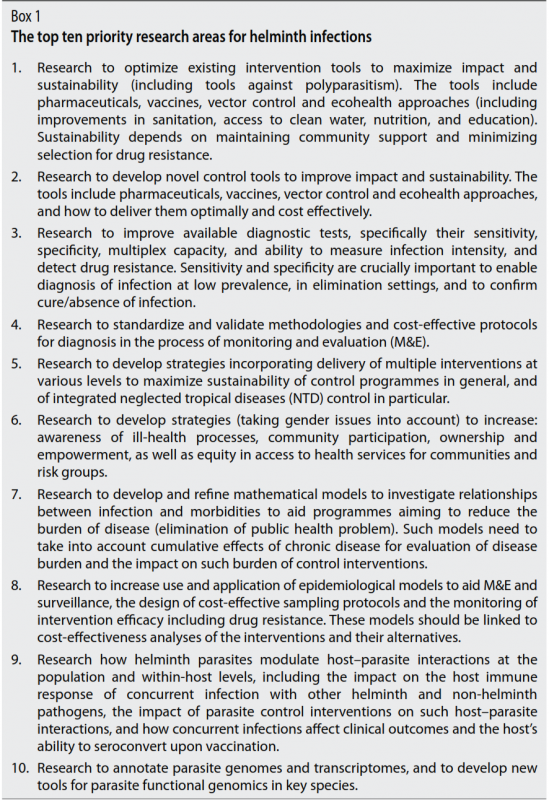 Top10resea...nths.png
(Filesize: 706KB)
Top10resea...nths.png
(Filesize: 706KB)
Please Log in to join the conversation.
You need to login to reply- rsilveti
-
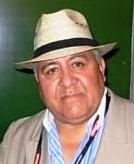 Less
Less- Posts: 18
- Karma: 1
- Likes received: 8
Re: Developing a uniform Soil-transmitted helminth (STH) analysis consortium for analyzing fecal waste samples (DUT, South Africa) - helminth egg measurements
Between 2009 and 2010 we conducted this study "Ascaris viability and assessment of risk for a vermicomposting ecological sanitation system in El Alto, Bolivia" with the support of Phillip Collander of the Emory University.
This is a summary of the procedure and protocol used for this study and is the same we use today. I copy the text from the document below in this forum post, but the full document with photos is available in this document:
Please log in or register to see it.
It is based on the manual of procedures for organic fertilizers the Ministry of Health of El Salvador, which is attached here:
Please log in or register to see it.
Raul D Silveti
+++++++++
Ascaris viability and assessment of risk for a vermicomposting ecological sanitation system in El Alto, Bolivia
Study Description and Context
This study was undertaken to examine the fate of Ascaris ova in a vermicomposting Ecological Sanitation system in El Alto, Bolivia, as well as to estimate health risks from viable Ascaris ova present in the vermicomposted excreta. Counts of viable and total Ascaris ova recovered from composts treated for 3 to 18 months are presented. Bayesian analysis is used to estimate the decay rate of Ascaris ova within the composts, and quantitative microbial risk assessment is applied to project the burden of disease from Ascaris infection that may result from the use of vermicomposted biosolids from this system to agricultural crops or public green space.
This research was performed in collaboration with the Bolivian NGO Sumaj Huasi, which, at the time of the study, provided ecological sanitation services to 687 households (the number has since grown) in the marginalized neighborhoods of San Roque and Villa Mercurio, on the northwestern outskirts of El Alto. The area’s population is mainly comprised of recent immigrants to the city, many of whom live in houses that have only been partially constructed. There are no municipal sanitation or garbage services, and the area is highly polluted with garbage and human and animal excreta. Sumaj Huasi collaborates with residents to help them build urine- diverting ecological toilets on their properties, and provides excreta collection and disposal services.
The sanitation services provided by Sumaj Huasi consisted of bimonthly pickup of stored urine and feces (mixed with ~65% bulking materials such as sawdust and kitchen waste) from household toilets and delivery of the materials to one of two composting centers in San Roque or Villa Mercurio. The composting center at San Roque is a walled facility featuring several large plastic tanks for the storage of urine, a well for drawing water, four vermicomposting pits holding approximately 0.85 m3 of compost each, and an experimental facility for testing the effects of the compost on plant growth. After collection, the material is seeded with Eisenia fetida and maintained at 60-70% humidity through the addition of well water obtained on-site, as well as the use of a mesh cover to scatter radiation and retain moisture. Material is composted in the same container for the duration of its treatment.
The composting center at Villa Mercurio was still under development at the time of this study. There were no facilities for urine storage and no wall to prevent intrusion by animals. The composting pits at Villa Mercurio were larger and of irregular size. Composting material was gathered and prepared in a similar manner to the site at San Roque, but was moved from pit to pit depending on its age.
At both composting sites, the ambient environmental conditions were those of El Alto in general. The climate of El Alto, which is roughly 13,500 feet above sea level, is that of a high altitude desert. Average temperatures year-round hover near 7° C with large differences in temperature between sunlight and shade. Temperatures often fall below 0° C, especially at night and during the winter months (June- September). The area receives 23.74 inches of rainfall per year on average, with the majority of precipitation occurring between December and March.
Study Rationale
This study addresses important gaps in knowledge regarding the sanitization of biosolids and potential disease risks in ecological sanitation systems. The quantification of Ascaris ova and estimation of ova inactivation rates provide valuable data and evidence on the fate of helminth ova in vermicomposts. This issue has not been well-resolved in the scientific literature and is of growing importance as ecological sanitation gains prominence in international development projects. The quantitative microbial risk assessment provides estimates of the health risks from reuse of Ecosan excreta in several scenarios, and is one of very few risk assessments for Ascaris infection propagated by reuse of composted biosolids in horticulture.
In addition to the scientific needs addressed by the study, the practical information needs of Sumaj Huasi and the population they serve are also addressed. Sumaj Huasi operates on grants from the Swedish Development Agency (SIDA), but the long term sustainability of their sanitation services will depend on the possibility of marketing the processed urine and biosolids as fertilizer for horticultural use. The results of the QMRA performed in this study will inform policy recommendations to help Sumaj Huasi achieve safe reuse of the excreta they process, and will hopefully contribute to the financial sustainability of their sanitation services.
Study Significance
The information and analyses in this study will contribute to the body of knowledge on sustainable sanitation interventions for low-resource settings, which are crucial for the prevention of millions of deaths and disease episodes each year and pertinent to economic development and environmental sustainability. The analyses from this project will directly benefit the providers and beneficiaries of an ecological sanitation system in El Alto, Bolivia, and help to ensure the safety and sustainability of that system.
Methods
Sampling
At the San Roque site, nine samples of roughly 100 g were drawn from each of three vermicomposting trenches, containing material that had been composting for
3, 8, or 13 months. At the Villa Mercurio site, three samples of roughly 100 g were drawn from each of two vermicomposting trenches, containing material that had been composting for 6 or 18 months. Samples were drawn from a wide spatial distribution within each pit, using a trowel to take material from the top, middle (roughly 20 cm deep), and bottom layers (roughly 40 cm deep). After collection, samples were transported to the laboratory at Universidad Mayor de San Andreas, Cota Cota, and stored at 4º C.
Recovery and Quantification of Ascaris Ova
Composite samples meant to represent all strata of the composts were created by combining 20 g of compost from the top, middle, and bottom layers of each sample. Each 60 g composite sample was then processed using a protocol adapted from the United States Environmental Protection Agency method for detection and viability determination of Ascaris ova in sludge [12]. To summarize, the samples were suspended in 200 mL of distilled water overnight at 4º C. On the following day, the samples were homogenized in a blender and stored overnight in 0.04% Linbro 7X at 4º C. Next, the samples were re-suspended in 0.1% Linbro 7X and filtered through a porosity #20 sieve in order to remove large particles. After being stored an additional 2 hours at 4º C, the samples were transferred to 50 ml conical tubes, with roughly 10 mL of sediment per tube. After addition of distilled water to a volume of 50 ml, the conical tubes were centrifuged at 1000 x g for 10 minutes, and the supernatant was discarded. Magnesium sulfate solution with a specific gravity of 1.2 was added to each conical tube, and the sediment was resuspended, mixed, and centrifuged at 900 x g for 10 minutes. The supernatant, containing ova, was then poured through a porosity #400 sieve, retaining the ova on the top mesh. Using distilled water, the ova were rinsed into 15 mL conical tubes, and stored in 4 mL 0.1N sulfuric acid.
The 15 mL conical tubes containing the recovered ova were incubated at 28º C. Concurrent to the incubation of each sample, a positive incubation control was created by adding 5,000 Ascaris suum ova (Excelsior Sentinel Inc.) to 4 mL 0.1 N sulfuric acid, labeled with the date, and placed in the incubator. Samples and incubation controls were shaken daily for aeration, and their fluid volume was maintained by addition of distilled water. After 15 days of incubation, a small aliquot of the incubation control was placed on a microscope slide, and 100 ova were counted. If 90% of the ova counted in the positive control were embryonated to the infective stage, the sample was withdrawn from incubation and counted. If less than 90% of the eggs were embryonated to the infective stage, the incubation control was replaced in the incubator, and checked again after one to two days.
After 90% of the incubation control eggs had embryonated, samples were placed in a 40º C water bath for 3 minutes in order to induce movement in any larvae present. The total volume of each sample was recorded prior to counting, the sample was shaken to resuspend the ova, and 1.5 mL were transferred to a 1,000 square Sedgewick-Rafter slide. Using a light microscope, ova and larvae were counted in
100 grid squares, moving diagonally so as to include both central and peripheral grid squares in the count. The number of observed helminth larva and Ascaris ova were recorded by square, and classified as unembryonated (no cell divisions evident, undefined mass in center of egg), embryonated (some development and cell division visible), embryonated with immature larva, or embryonated to the infective stage (fully developed larva visible inside of egg). Any movement of larvae was recorded. All ova embryonated to the infective stage were assumed to be viable.
Measurement of Physical Characteristics of the Compost Samples
Composite 20 g samples were created by adding together 6.67 grams from the top, middle, and bottom layers of each compost sample. Each 20 g composite sample was mixed into 20 mL of distilled water, and pH was measured using a pH electrode (Oakton® Acorn pH 6).
Percent humidity was measured for each sample by placing a plastic cup on a balance, and adding to the cup 10 g from each sample layer to give a total of 30 grams. Plastic cups loaded with sample were then placed in a large cardboard box covered in gauze, and stored at ambient temperature. Cups were re-weighed each consecutive day until their weights stopped changing, and the ratio of the total dry weight minus the weight of the plastic cup to the total original weight minus the weight of the plastic cup was used to calculate percent humidity.
Attachments:
-
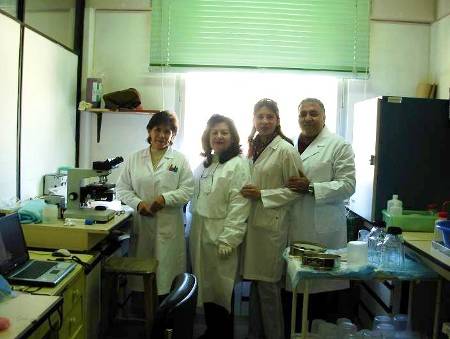 picturefromlab.jpg
(Filesize: 25KB)
picturefromlab.jpg
(Filesize: 25KB)
Please Log in to join the conversation.
You need to login to reply- Thor
-
Less
- Posts: 2
- Likes received: 0
Re: Developing a uniform Soil-transmitted helminth (STH) analysis consortium for analyzing fecal waste samples (Durban Uni of Technology, South Africa)
Naturally we are willing to cooperate with you in the future. We are currently planning for a workshop in late August related to this Gates project, when we will discuss different alternative methods and try to reach a consensus on methods as well as validation and QA/QC procedures.
Could you share the methodological protocol and validation procedures that you are currently using? We will then bring it up for comparison and give you feedback in relation to this and our conclusions.
Best Regards and hope to see you again in the near future.
Thor-Axel Stenstrom
Please Log in to join the conversation.
You need to login to reply- rsilveti
-
 Less
Less- Posts: 18
- Karma: 1
- Likes received: 8
Re: Developing a uniform Soil-transmitted helminth (STH) analysis consortium for analyzing fecal waste samples (Durban Uni of Technology, South Africa)
Saludos,
Raul Silveti
Please Log in to join the conversation.
You need to login to reply- Elisabeth
-
Topic Author
- User is blocked
- Freelance consultant since 2012
Less- Posts: 3372
- Karma: 54
- Likes received: 932
Developing a uniform Soil-transmitted helminth (STH) analysis consortium for analyzing fecal waste samples (DUT, South Africa) - helminth egg measurements
Title of grant: Developing a uniform Soil-transmitted helminth (STH) analysis consortium for analyzing fecal waste samples
- Subtitle: To develop publicly available environmental analytical methods that present uniformity and consistency in assessing and quantifying the global problem with Soil Transmitted Helminths and their detection
- Name of lead organization: Durban University of Technology
- Primary contact at lead organization: Prof. Thor-Axel Stenstrom - Head of Department; Lusanda Matshatshe Project Administrator; Julian Arran - Project Administrator
- Grantee location: Durban, South Africa
- Developing country where the research is being tested: South Africa
- Start and end date: 26 January 2015 - 30 June 2016
- Grant size in USD: $ 385,363 (as per grant database )
The project aims to set up a co-ordinary QA/QC (quality assurance and quality control) system for environmental assessment and quantification of Soil Transmitted Helminths (STH) with special focus on Ascaris . Various samples will be used including but not limited to: Faecal sludge, UDDT fecal matter, sewage sludge, Soil and wastewater/water. This will involve selected laboratories on different continents that either have ongoing or recently finished agreements with the Gates Foundation or have a well-defined track record of environmental investigations . Comparative methodological assessments will be done focusing on different sampling regimes as well as on recovery, precision, accuracy and sensitivity aiming towards a standardized and recognized reference method. Additionally the coordinated efforts will create a network of global partners in the area of methodology for assessing risks with soil transmitted helminths.
Currently there are various methods employed globally for the detection of STHs ova in environmental samples, the sensitivity of these methods vary from one researcher/laboratory to the other. This leads to the lack of uniformity in the estimation of risk to exposed populations. Therefore there is the need to assess the sensitivity and selectivity of the various methods used in STHs detection and possibly develop a uniform method that can be applied in both developing and developed countries to assess STHs ova concentrations.
The methods should be able to identify STHs eggs in general and also determine if they are viable: Other STHs include Trichuris trichuira, Hookworms (Ancylostoma duodenale and Necator americanus), Teania spp.
Goal(s):
This work will result in publically available environmental analytical methods that presents uniformity and consistency in assessing and quantifying the global problem with Soil Transmitted Helminthes and their detection
The main focus is on quantifying STHs in the environmental samples, no epidemiological studies are planned as part of this project.
Objectives:
- Enrolment of staff and support functions as well as aligning a dedicated laboratory for the further QA/QC investigations. The alignment of a suitable lab, involves the determination of other labs involved in the same field.
- Pre-assessment report of the methods that will be used for comparative testing and of methodological approaches. Currently the number and type of methods to be used are not constant, methods will be decided based on the workshop in August, in Durban South Africa.
- Workshop planning and enrolment of participants , which may be corporate or other non-profit organisations, whether they be fellow researchers/institutes, labs, universities worldwide involved with Gates grants or working on a similar topic.
- Execution of a workshop
- Synthesis of workshop outcomes
- Methodological comparative testing, this involves analysis of the various methods used in other labs to establish one globally accepted and practiced method for the detection of STH.
- QA/QC procedures and inter-laboratory procedures
- Result compilation and statistical evaluation
- Synthesis Report and potential joint publications, with other labs that working on the same topic, not necessarily looking at the point where medical doctors are involved with testing
Research or implementation partners: University of Kwazulu-Natal in Durban, South Africa
Links, further readings – results to date: None available yet
Current state of affairs: This project is currently in a start-up phase (it only started end of January 2015)
Biggest successes so far: Not available yet
Main challenges / frustration: Not available yet
If you have questions or comments for Thor and his team about this grant, please post them in this thread. Thanks.
For a visual impression of helminth analysis see here three photos of helminth analysis from another project in Mexico :
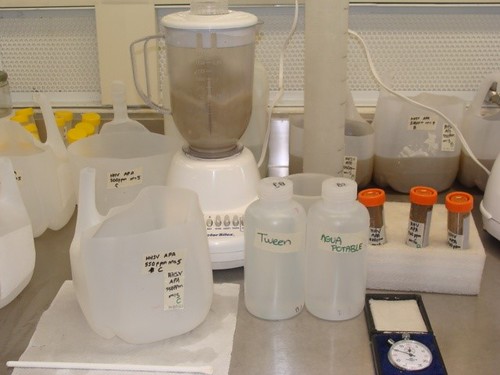

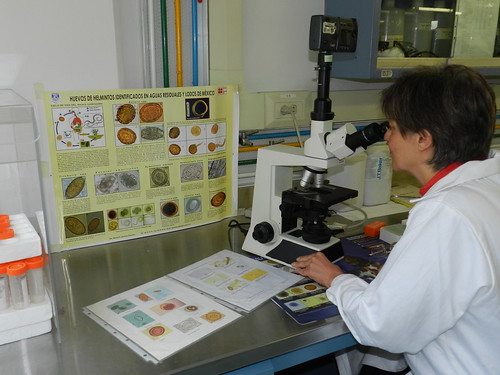
Regards,
Elisabeth
++++++++
* If you are new to the topic of soil-transmitted helminthiasis, see also here on Wikipedia (a page that I have helped to improve):
en.wikipedia.org/wiki/Soil-transmitted_helminthiasis
Freelance consultant on environmental and climate projects
Please Log in to join the conversation.
You need to login to reply- Forum
- categories
- Sanitation systems
- Faecal sludge management (FSM)
- Determining helminth egg quantities (measurement techniques)
- Developing a uniform Soil-transmitted helminth (STH) analysis consortium for analyzing fecal waste samples (DUT, South Africa) - helminth egg measurements







